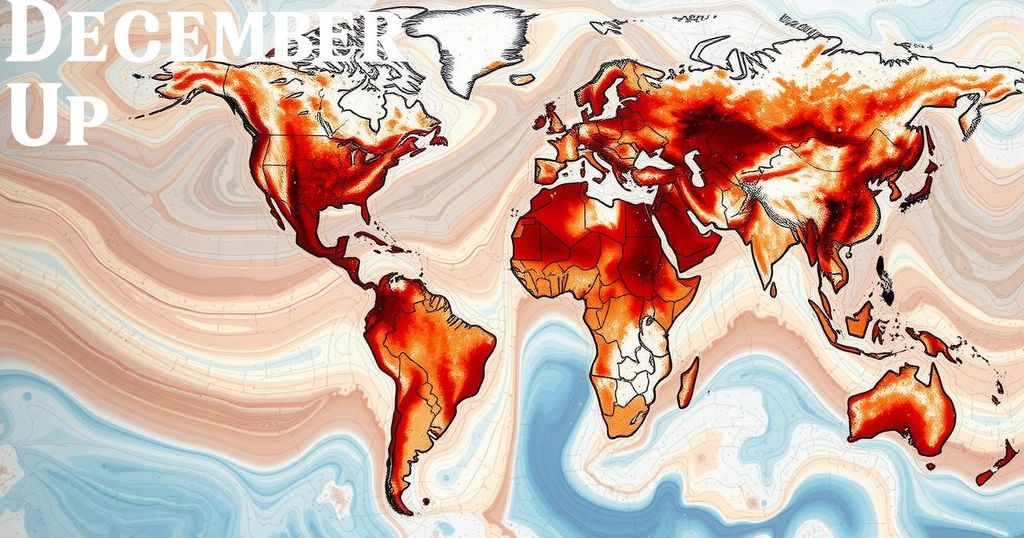2023/2024 El Niño: Analyzing Profound Global Impacts on Weather and Society

The 2023/2024 El Niño episode is one of the most intense on record, leading to widespread extreme weather events that have impacted over 60 million people worldwide. Southern Africa experienced the most severe droughts, while flooding displaced millions in other regions. This phenomenon exacerbates existing vulnerabilities linked to climate change and conflict, resulting in significant food insecurity and health crises.
The 2023/2024 El Niño episode has emerged as one of the most intense occurrences in recorded history, with ocean temperature anomalies reaching 2°C above normal in the Pacific region. A recent report from World Weather Attribution indicates that this significant warming phase was a primary factor behind a series of extreme weather events occurring globally between September 2023 and May 2024. This phenomenon has manifested in serious drought conditions in various regions, such as Central America, Colombia, and Southern Africa, alongside widespread flooding in locations including Brazil and parts of East Africa.
The scope of the El Niño-induced impacts is staggering, with over 60 million individuals affected, particularly among vulnerable populations grappling with intertwined challenges related to climate change, socio-economic factors, and conflict. Southern Africa experienced the brunt of the crisis, as more than 30 million people faced devastating droughts that devastated local economies and escalated food insecurity. In Eastern Africa, the relentless floods displaced thousands and left lasting economic scars, affecting approximately 5 million individuals. Additionally, the Philippines reported severe drought conditions impacting over 4 million people, while Central America saw 1.3 million individuals affected, and Brazil grappling with the aftermath of catastrophic flooding impacting over 2 million residents.
Beyond the immediate effects on food security, the consequences of El Niño are formidable, presenting compounding challenges for marginalized communities. Regions affected by flooding have witnessed an alarming rise in disease outbreaks, such as cholera and malaria, further stressing limited healthcare resources. Vulnerable groups, notably women and children, are disproportionately affected, facing escalating risks associated with displacement, poverty, and gender-based violence as socio-economic systems destabilize.
The economic ramifications of El Niño are manifesting across various affected areas, deepening existing vulnerabilities. As local livelihoods suffer due to environmental crises, communities find themselves trapped in a cycle of increasing hardship, which, if unaddressed, threatens to exacerbate the broader implications of climate change and economic inequity.
It is imperative for stakeholders to recognize the extensive and multifaceted effects of the current El Niño, to mobilize resources effectively, and to enhance resilience amongst those most at risk.
This imposed urgency from the ongoing crisis calls for a concerted effort toward mitigation strategies and comprehensive support for those enduring the harsh realities attributed to this climatic phenomenon, ensuring that humanitarian assistance and resources are made available swiftly to alleviate suffering and foster recovery.
The El Niño Southern Oscillation (ENSO) is a significant driver of global climate variability and has profound effects on weather patterns around the world. The warming phase, known as El Niño, results in elevated ocean temperatures, influencing atmospheric conditions and triggering diverse extreme weather events ranging from droughts to heavy flooding. Its impacts can disrupt agriculture, lead to humanitarian crises, and increase risks of disease and socio-economic instability, particularly in vulnerable communities. Understanding the breadth of El Niño’s consequences is critical for developing effective response strategies and supportive measures for affected populations.
In summary, the ongoing El Niño episode of 2023/2024 has shown to be one of the most severe in history, resulting in widespread impacts including devastating droughts and floods that have affected over 60 million people globally. The situation is particularly dire in Southern Africa and Eastern Africa, where communities are grappling with food insecurity, health crises, and economic instability. These findings emphasize the urgent need for comprehensive strategies and immediate action to support vulnerable populations and mitigate the long-term effects of climate-related challenges.
Original Source: reliefweb.int






